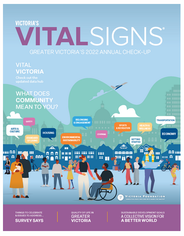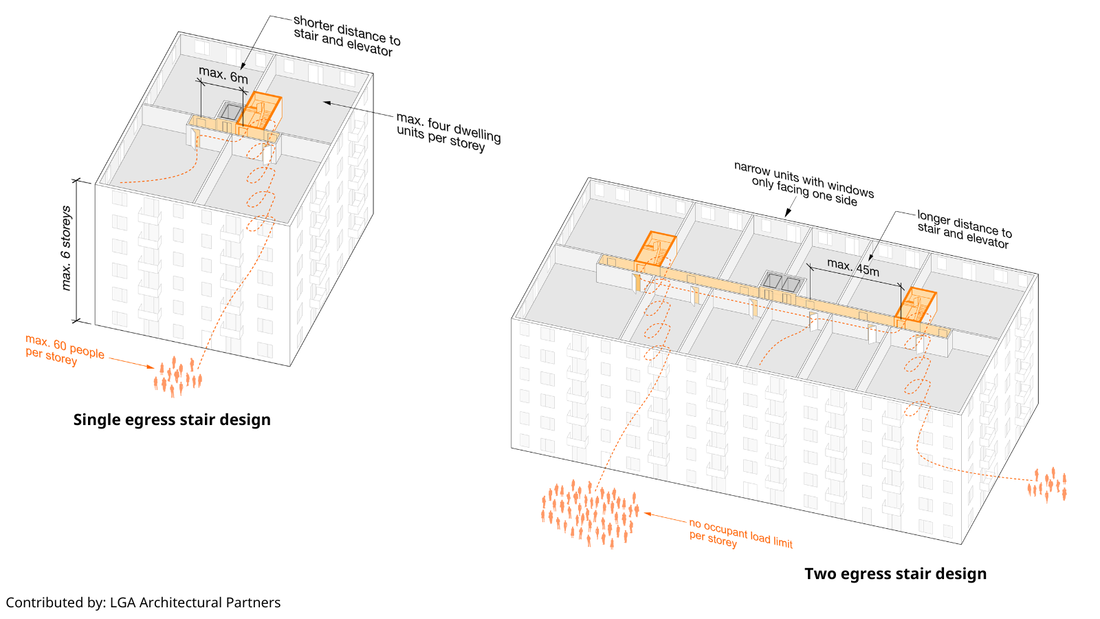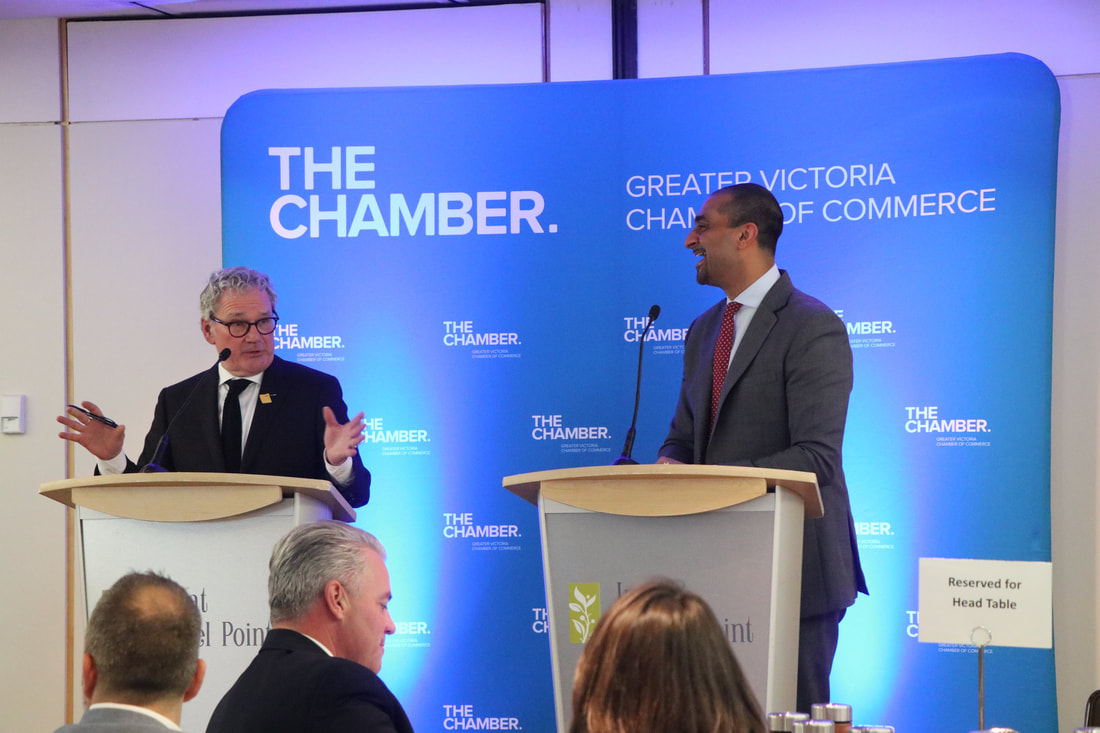|
A new tower that will create a notable landmark for people entering Greater Victoria's core has been approved by District of Saanich council.
The 24-storey apartment building will house 318 rental units on the corner of Carey Road and Ravine Way. A residential building on the site was part of the original proposal for Uptown. The new building will also include commercial space and cycling amenities. Saanch has a long-range vision for transforming the neighbourhood into a central hub that will become the heart of the municipality. More homes.
That's the simple answer to so many of the complex challenges affecting our economy — from attracting and keeping workers to providing shelter for people camping on city streets. The Chamber consistently advocates for policy changes and investment that will boost our housing supply. And we applaud the latest announcement this week that sees a pilot Building Permit Hub begin operations in select regions of the province, including in the City of Victoria and the District of Saanich. The online tool is expected to be available at the local level this summer. The goal is to streamline and standardize local permitting processes that can be complicated and delay home construction. "This new one-stop shop for local building permits will reduce red tape for homebuilders, local governments and First Nations, and ultimately save money, speed up construction and help people get into homes faster,” BC Premier David Eby said in a news release. The new hubs:
The Chamber is working to engage with members and our partner organizations to make sure the voice of business is heard on proposals that will impact traffic in downtown Victoria.
The City of Victoria is looking at extending dedicated bus lanes along Douglas Street, potentially reworking the busy corridor to focus on transit. The idea would take more than a year of study before returning to council. Chamber CEO Bruce Williams told the Times Colonist that making transit more convenient is a good thing. Giving commuters an option other than single occupancy vehicles will help with congestion and emissions. However, changing downtown streetscapes will require consultation with businesses that could be impacted by changes to traffic patterns and potential loss of parking spaces. "We don't want to deter people from going downtown to shop, enjoy a meal or have some fun in the city," Williams said, noting that any transportation plan for the city needs to consider how convenient it is for people travelling from neighbourhoods outside downtown Victoria. One proposal — also in the early stages — is to look at developing a new parkade near north Douglas to allow people to park close to downtown and then walk into the compact central core. Greater Victoria's two largest municipalities continue to show they can play nice with each other. The latest example is a joint media release regarding mutual initiatives that incentivize owners of rental buildings to convert to electric power.
"The City of Victoria and the District of Saanich recently announced tax exemption programs that support electrification retrofits in rental buildings, the first initiative of its kind in British Columbia," the release stated. "In tandem, the municipalities have partnered with Landlord BC and BC Hydro to expand the Rental Apartment Retrofit Accelerator (RARA) Program, initiated in Vancouver in 2023." The mayors of Victoria and Saanich said the programs will help reduce fossil fuel consumption in the region, and provide access to summer cooling during future heat waves. On Tuesday, the provincial government released the next round of municipalities facing scrutiny to ensure they are helping increase BC's housing supply.
The next 20 priority municipalities include the following in Greater Victoria:
The first list, released last spring, included the City of Victoria, the District of Saanich and the District of Oak Bay. Each community receives a target number of total units that are expected to be built within a specific time-frame. The targets for the latest communities will be made public this summer. "The Chamber supports efforts to increase housing supply and we continue to advocate for all levels of government to smooth the process for builders so the construction work needed can be done," Chamber CEO Bruce Williams said. "I'm looking forward to speaking with Premier Eby next week at the Chamber breakfast to hear firsthand how the province is advocating for support from the federal government." The Chamber hosts Premier Eby on April 30. Register now to reserve your seat at the table. Talk is turning to action on the latest attempt to pursue municipal amalgamation. Invitations to serve on the Victoria-Saanich Citizens' Assembly have been sent to 10,000 residents in the two communities. They have until May 30 to confirm whether they will participate.
From there, 48 people will be selected through a randomized lottery process that fairly represents the population of both municipalities. Finally, the committee will come together over eight Saturdays starting in September and wrapping up in April. At that point, they will produce a report outlining the pros and cons of merging Greater Victoria's two largest municipalities. As part of the plan for transforming the Uptown corridor, the province is proposing changes to Ravine Way to accommodate new bus stops and expanded trails in the area.
An information session is scheduled for May 1, from 3-7 pm at Cedar Hill Golf Course, to review design concepts, get feedback and discuss how to improve the area for people travelling by bus, foot, bicycle, wheelchair or scooter. The Chamber has kept a watchful eye on the promise of better governance from fewer governments in our region. We're pleased to see the City of Victoria and the District of Saanich have taken the next step to explore the pros and cons of merging municipalities. A Toronto-based agency has been hired to create a Citizens' Assembly, and has launched a new website at victoriasaanich.ca. The website highlights the following steps:
The Secondary Suites Incentive Program, introduced to all BC municipalities last fall, is being expanded to 16 regional districts, including the Capital Regional District.
“We’re using innovative solutions to make it easier for homeowners and communities to build homes faster, so people can live and work in the communities they love,” BC Minister of Housing Ravi Kahlon said in a news release. The three-year pilot SSIP will provide about 3,000 homeowners with forgivable loans for as much as $40,000 to create a new secondary suite or an accessory dwelling unit on their property. To qualify, the units must be rented below market rates for at least five years. In a separate news release, Kahlon also announced that the province issued a request for proposals that could lead to BC adopting an innovative housing solution used in places such as Seattle and New York City. A common practice in Europe, the solution involves allowing single staircases in residential buildings by updating an 80-year-old rule in BC's building code that currently requires two stairwells. The change would allow for larger apartments with more daylight, cross breezes and greenspaces. "The Chamber encourages all levels of government to embrace innovations that allow builders to provide the housing supply we need," Chamber CEO Bruce Williams said. "Looking at how other places in the world have solved the same issue we face makes sense." A new report offers insight into how shifting consumer behaviours are changing the way small businesses operate post pandemic.
On Monday, the Canadian Chamber of Commerce’s Business Data Lab released A Portrait of Small Business in Canada: Adaption, Agility, All At Once. The findings shed light on how businesses can thrive despite the rising cost of doing business, the highest borrowing costs in over two decades and the increased pandemic debt loads. Examples for businesses include investing in technology, staying agile to embrace shifting trends and working with their chamber to call for less red tape from government. The report also explores the unique realities, challenges and opportunities for small businesses owned by women, persons with disabilities, members of the LGBTQ2s+ community, immigrants to Canada, Indigenous peoples and visible minorities. Provincial regulations announced in the summer are set to take effect this month, banning certain single-use plastics in BC. The rules aim to prevent single-use and plastic waste, divert more waste from landfills and keep consumer products working longer.
Starting Dec. 20, businesses can't use:
By customer request only or from a self-service station:
The Chamber supports innovation done by business to meet public demands and reduce waste. We will continue to work with regulators to ensure regulations address the changes already implemented by businesses championing climate action leadership. Greater Victoria saw a jump in the value of residential permits in September compared to the same month last year.
The total value of residential permits in September was $203.8 million, compared to $175.9 million in September 2022. The region also posted a 134% jump from August, which saw $87.1 million worth of residential permits issued. Across Canada, the total monthly value of residential permits increased 4.3% to $7.2 billion in September, led by a 37.2% monthly increase in construction intentions in British Columbia. The new building permits account for 21,700 new dwelling units nationwide, 5.6% more than August 2023 and 2.3% more than September 2022. The targets are now official for three Greater Victoria municipalities deemed to be among the top 10 BC communities with the most pressing housing needs.
The Housing Supply Act requires the following number of new homes within five years:
“These targets are a step toward creating more homes to meet the diverse housing needs of Saanich residents,” Saanich Mayor Dean Murdock said in the province's news release. “We are committed to working together with the Province on housing solutions, and welcome their support to help us achieve our goals.” After six months, and every year thereafter, municipalities will be evaluated on their progress. A second cohort of eight to 10 municipalities will be selected by the end of the year. An adequate housing supply directly supports a robust workforce, which is critical for employers' efforts to find and keep staff. Reducing red tape at the municipal level is one of the keys. Investing in efficiencies is another, which is why The Chamber supports last week's news that funding will help local governments improve their development-approval processes.
The province has $61-million in capacity funding to be distributed over three years. Housing supply is emerging as the root of many challenges facing Greater Victoria and the economy of Canada as a whole. To try and address some of the foundational causes of a lack of housing, the Community Social Planning Council has released a toolkit for local government. Local Government Levers for Housing Affordability addresses how housing affects everything from "staffing shortages to wage pressure to homelessness."
The document gathers policy tools that have been used successfully by large and small municipalities across the country. Creating more housing supply is key to making Greater Victoria more economically sustainable. Employers need staff, and employees need to be able to afford where they live. With homes in high demand in our region, we need all levels of government to be part of the solution.
The Chamber applauds the recent decision by the District of Saanich to create more homes in the municipality. The New Small Apartment Infill Zone will allow single-family lots to be redeveloped as multi-unit apartments. There are guidelines to ensure the zoning is used on appropriate lots. “We have heard that there’s an interest in building these in Saanich,” Saanich Mayor Dean Murdoch told the Times Colonist. “We’ve got a very large university and college campuses in Saanich and there’s a desire to build housing types like this that would serve that student population.” The latest report from the Canadian Mortgage and Housing Corporation shows an increase in new homes being built in Greater Victoria. That's good news, as The Chamber continues to advocate for changes to regulations and investment in strategies that increase housing supply. We need homes that are affordable to workers because Greater Victoria's employers desperately need employees.
CMHC numbers show housing starts in our region were up 32.6% year over year. There were 1,088 housing starts from January to March, compared to 820 starts for the same period in 2022. The report shows that most of the new starts are condos and apartments as fewer single detached homes are being built. The City of Langford accounts for 537 of the new starts. The City of Victoria is home to 240 new starts and the Township of Esquimalt has 157. It's too early to forecast whether the increase will be sustained over the course of the year, as high interest rates impact investment. The report is also an indicator that some municipalities in our region are not creating their fair share of housing supply. Recent initiatives by the provincial government could help unlock potential housing in these areas. The Chamber's 160th annual general meeting took place April 18 at the Inn at Laurel Point.
After making sure operations and financials were in order, members in attendance were treated to a frank discussion with BC's Housing Minister Ravi Kahlon. Chamber CEO Bruce Williams emceed the session and asked about the provincial government's plan to increase housing supply. The minister noted that legislation had been introduced that morning that will help projects avoid time-consuming delays. Among other topics was a discussion about the need to remove barriers for skilled workers coming here from other countries and provinces. Delays in the recognition of credentials has been an ongoing concern for newcomers wanting to work in their chosen professions. Minister Kahlon encouraged The Chamber to continue advocating for change, noting the message is being heard. He pointed to efforts to increase BC's health care workforce that are beginning to pay off. Also discussed were increasing student housing to free up rental properties for workers, strategies to house the homeless and using public land to build non-market housing following models that have proven successful elsewhere. "The Chamber is grateful to Minister Kahlon for sharing his time with our members to talk about the many challenges facing housing in Greater Victoria and the province," Chamber CEO Bruce Williams said. "This year's annual general meeting was the 160th time we've reported to our members and we are working to make sure the next 12 months are successful for our organization, for all our member businesses and for everyone in our community." Rethinking governance in Greater Victoria has been a popular topic of coffee shops, talk radio and opinion columns for decades. The Chamber has long advocated for better regional services and we're happy to see the Citizens' Assembly process back on track between the City of Victoria and the District of Saanich.
On Monday, the mayors of Saanich and Victoria as well as two councillors from each municipality met to talk about next steps. The municipalities and the provincial government are splitting the $750,000 cost of holding a Citizens' Assembly. The assembly will have 27 people from Saanich and 21 from Victoria based on population. Ideally, it will also be representative of the municipalities' demographics regarding gender and age as well as the ratio of renters vs. homeowners and Indigenous population. A progress report is due at the end of this year. Almost everyone enjoys having the sun stick around a little longer in the evening. However, the switch to Daylight Savings Time this Sunday also creates challenges for many employers dealing with tired staff adjusting to the shift in routine.
WorkSafeBC issued a reminder that the change can create real risks for workers who drive for a living. “Fatigue is a type of impairment that reduces mental and physical performance,” Road Safety at Work program director Trace Acres said, noting people who drive for work could be more at risk of crashing as body clocks take time to catch up with alarm clocks. “Research shows (fatigue) is a contributing factor in about 20% of crashes.” Road Safety at Work suggests employers make sure their drivers know their responsibilities and procedures to deal with fatigue. The goal is to avoid risk by ensuring adequate breaks for fresh air, sticking to daylight hours when possible and scheduling outside of peak-accident time of 3 to 6 pm. The Chamber has advocated for an end to shifting clocks and helped convince the provincial government to survey British Columbians. The result showed 93% support for stopping the twice-annual time change. To avoid cross-border confusion, BC has said it's now waiting for the Pacific US states to get federal approval to also put a permanent end to the switch. A $204.8-million contract has been awarded for a major project that will see the Royal BC Museum build an important new facility in the City of Colwood.
Construction is expected to begin this summer on the museum's Collections and Research Building as part of a long-term plan to protect the Province’s collections, including more than seven million artifacts and the BC Archives. Total capital project costs for the building are valued at more than $270 million. The project is being undertaken in consultation with the Songhees Nation and Esquimalt Nation. The state-of-the-art facility will be 163,611 square feet and use mass timber construction to safely house the Province’s collections, BC Archives and research departments. There will also be dedicated research labs and learning spaces. “Alongside the safe and modern storage of the collections and provincial records, the (Collections and Research Building) will be a dynamic and welcoming community space,” RBCM CEO said Alicia Dubois said. “We hope to inspire future paleontologists, entomologists, botanists and historians through greater learning opportunities by enhancing public access to our work.” The new building will provide a secure location for a number of items that had been at risk, such as: archival books and manuscripts; rare and priceless artworks, including watercolours from the 1700s; several paintings by Emily Carr; and early provincial maps. The planned RapidBus route between the West Shore and downtown Victoria will be a game changer for commuters when it launches April 10.
The service will run every 15 minutes, making the ride more convenient. That's key for convincing people to leave their cars at home. Buses will run between 7am and 10pm Monday to Saturday and 8am to 10pm on Sundays. There will be additional buses during peak times on weekdays to improve customer experience, BC Transit said. "Smart regional transportation is important for businesses that depend on staff being able to get to the workplace," Chamber CEO Bruce Williams said. "Taking the bus instead of a car is much better environmentally, especially with BC Transit's commitment to reduce greenhouse gas emissions in its fleet." Businesses that service the real estate industry are a major contributor to Greater Victoria's economy. However, rising interest rates have slowed sales. Throw in the traditional quiet period around the holidays and fewer properties are changing hands. Only 384 sales were recorded in the region for November, down from 653 last November.
There are also concerns about potential unintended consequences of recent changes to the provincial Strata Property Act. "It is an open question whether these changes will bring any additional rental stock to the market — with BC's complex Residential Tenancy Act not all homeowners of vacant strata homes have a desire to become landlords and current interest rates are less attractive to investors who may want to purchase strata rental properties," Victoria Real Estate Board President President Dinnie-Smyth said in a news release. "It is also possible that these measures will contribute further to eroding housing affordability as older stratas with rental restrictions were generally valued lower than their rentable counterparts." Slower sales have also contributed to a slight dip in market values over the last few months. That could mean some property assessments — being sent out soon to homeowners from BC Assessment — will be higher than current market value. “I want to emphasize that assessments are based on July 1 values of this year, meaning that when similar properties were sold up to and around July 1, those market value sales are used to calculate your assessed value," Assessor Bryan Mura said in a news release. “An increase in assessment value does not, however, necessarily result in an increase in property taxes. Taxes are typically only affected if you are above the average value change for your community." A movement that initially took hold in the City of Victoria is set to become a Canada-wide initiative as of Dec. 20. The federal Single-Use Plastics Prohibition Regulations aims to stop the manufacture, import and sale of bags, cutlery and other items made with problematic plastics.
The Chamber worked closely with Victoria and other local governments. Our goal was to make sure the initial regulations incorporated innovations that businesses were already using to address consumer concerns. The public has, for many years, supported businesses that provided alternatives to plastic waste. Having the same rules across the country will help businesses work with the requirements efficiently and effectively.  Housing remains a drag on the vitality of our region, though overall quality of life in Greater Victoria has improved. According to the 2022 Vital Signs Report, released this week, Greater Victoria's grade has moved up from a B grade last year to a B+ this year. Housing earned an F grade this year, a significant drop from a D+ last year. "Vital Signs is a great check up on our region's economy, and The Chamber was happy to contribute as a community partner this year," Chamber CEO Bruce Williams said. "The grades are a good way to illustrate concepts that contribute to our overall quality of life." It's the 19th edition of the annual report, which uses surveys as well as stories and graphics to provide snapshots of the past year. This year's theme asked What Does Community Mean To You? Respondents rated the natural environment and climate as the best things about Greater Victoria. The aforementioned Housing crisis and cost of living were the two most important issues, according to the survey. The report looks at 12 areas, with grades ranging from a B-plus for Learning and Sports and Recreation, to an F for Housing and a C- for Health and Wellness. |
Categories
All
|
Copyright © 2021 Greater Victoria Chamber of Commerce. All rights reserved.
#100 – 852 Fort St., Victoria, BC V8W 1H8, Canada | Phone: (250) 383-7191
[email protected] | Site Map
#100 – 852 Fort St., Victoria, BC V8W 1H8, Canada | Phone: (250) 383-7191
[email protected] | Site Map
Notice a typo or broken link? Please let us know so we can fix it ASAP. Email [email protected]




